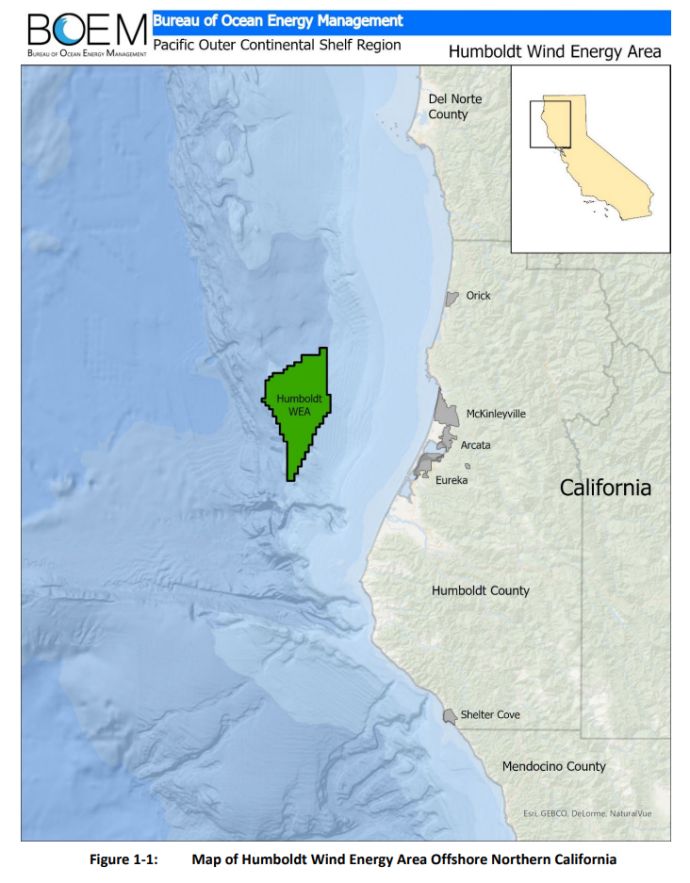On May 5, 2022, the US Bureau of Ocean Energy Management
(BOEM) announced that
it had completed an environmental assessment (EA) and issued a
finding of no significant impacts (FONSI) for offshore wind energy
activities in the Humboldt Wind Energy Area (WEA) located 20 miles
offshore northern California. BOEM initiated the environmental
review on July 28, 2021, and published a draft EA on January 11,
2022, for public review and comment.
BOEM's EA considers potential impacts from the issuance of
leases within the Humboldt WEA, which comprises nearly 132,369
acres (206.8 square miles) off the coast of Humboldt County,
California, as depicted on the map below. The Humboldt WEA, if
developed, could bring up to 1.6 GW of clean energy to the grid,
enough to power approximately 560,000 homes. The EA also considers
potential environmental consequences of site characterization
activities (e.g., biological, archeological, geological and
geophysical surveys), site assessment activities (e.g.,
installation of meteorological buoys) and project easements and
related right-of-way grants for subsea cable corridors in the
Humboldt WEA.
If all goes as planned, BOEM will hold its first competitive
auction for offshore wind leases for areas off the Pacific Coast
this year. Next for the Humboldt WEA, BOEM will issue a Proposed
Sale Notice for one or more areas to be auctioned and commence a
public review and comment period. Based on comments received, BOEM
may then issue a Final Sale Notice that sets the auction date,
lease areas to be auctioned and the auction format.
The Outer Continental Shelf off the Pacific Coast is not subject to
the upcoming offshore leasing moratorium provided for in former
President Trump's September 2020 memorandum, which stated:
"I hereby withdraw from disposition by leasing for 10 years,
beginning on July 1, 2022, and ending on June 30, 2032: The portion
of the area designated by the Bureau of Ocean Energy Management as
the Mid Atlantic Planning Area that lies south of the northern
administrative boundary of North Carolina" (the administrative
boundary depicted on the Atlantic NAD 83
Federal Outer Continental Shelf (OCS) Administrative Boundaries
map).
Importantly, BOEM leases do not authorize any activity in the lease
area but instead only grant a lessee the exclusive right to submit
plans for BOEM's consideration. Leasing marks the beginning of
a multi-year process, which provides additional opportunities for
stakeholder participation. A successful lessee would need to submit
to BOEM a Site Assessment Plan (SAP) within the first year after
lease issuance, unless granted an extension. The SAP describes the
initial site assessment and characterization activities necessary
to assess siting a project within the lease area for commercial
offshore wind development and the potential impacts of those
proposed activities. Only after BOEM approval of the SAP can a
lessee begin activities assessing the site. A lessee would also
need to submit a Construction and Operation Plan (COP) for BOEM
approval that details the onshore and offshore construction and
operation of the wind energy project. Based on the project-specific
details in the COP, BOEM would then conduct additional
environmental and technical reviews in deciding whether it could be
approved, and construction could begin.

Visit us at mayerbrown.com
Mayer Brown is a global legal services provider comprising legal practices that are separate entities (the "Mayer Brown Practices"). The Mayer Brown Practices are: Mayer Brown LLP and Mayer Brown Europe - Brussels LLP, both limited liability partnerships established in Illinois USA; Mayer Brown International LLP, a limited liability partnership incorporated in England and Wales (authorized and regulated by the Solicitors Regulation Authority and registered in England and Wales number OC 303359); Mayer Brown, a SELAS established in France; Mayer Brown JSM, a Hong Kong partnership and its associated entities in Asia; and Tauil & Chequer Advogados, a Brazilian law partnership with which Mayer Brown is associated. "Mayer Brown" and the Mayer Brown logo are the trademarks of the Mayer Brown Practices in their respective jurisdictions.
© Copyright 2020. The Mayer Brown Practices. All rights reserved.
This Mayer Brown article provides information and comments on legal issues and developments of interest. The foregoing is not a comprehensive treatment of the subject matter covered and is not intended to provide legal advice. Readers should seek specific legal advice before taking any action with respect to the matters discussed herein.


